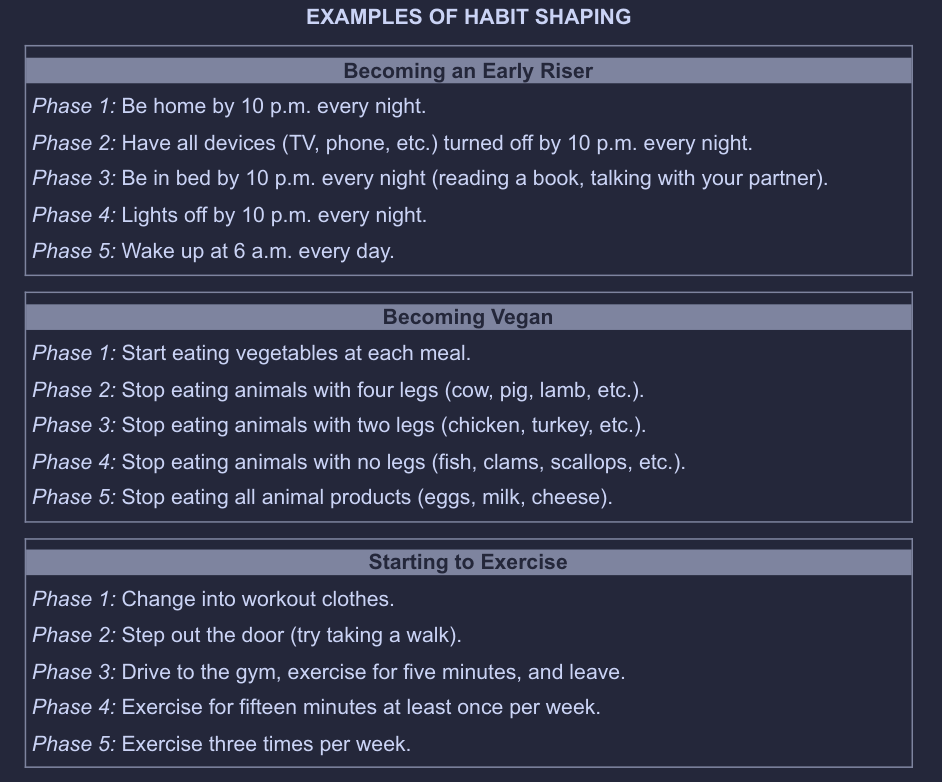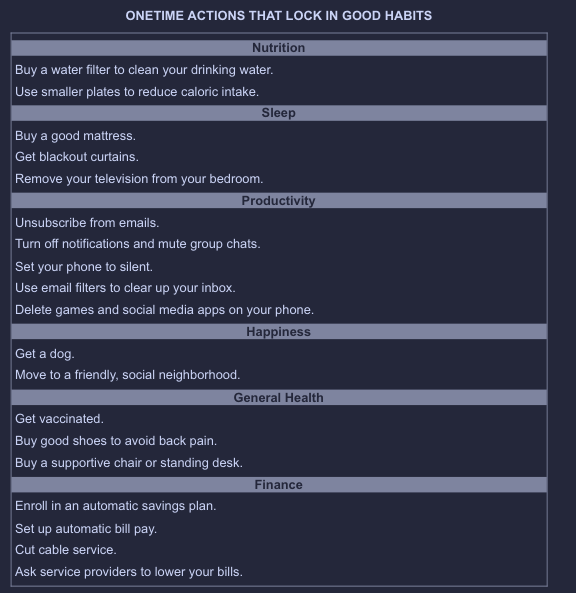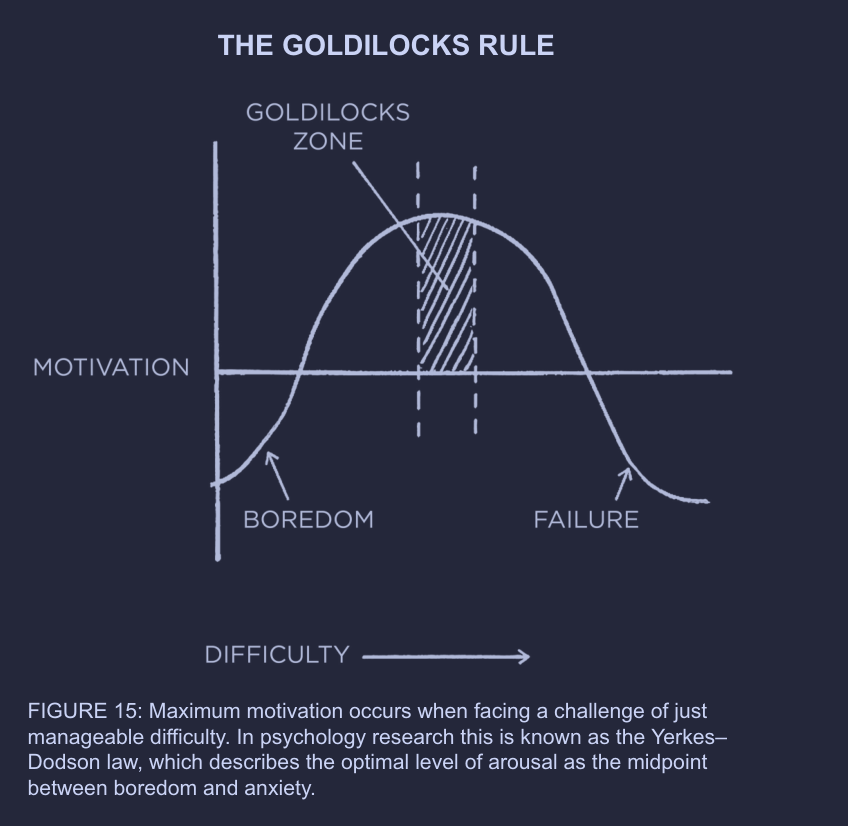Atomic Habits
# My opinion on this book
I think this book really is interesting and is worth a reading. I was too cautious while reading it because at first I felt the coach type of book vibe on which I don’t have good experiences, especially when the book starts denominating “laws” on things that are just concepts the author created (or facilitated).
But still the book is nice, its written in a very simple way with more logic arguments that try to convince you, and one of the main arguments is related with evolution (humans have changed too much in too little time and its software is still almost the same as thousands of years ago hence we have to take advantage of this somehow).
I believe many of the points he makes are valid, but not all of the tools the author provides might be of use for everyone, also, using tools that make taking notes and doing the activities on the book would make this a lot more valuable, tools like obsidian (or other less open tools like notion, loqseq etc etc) which make taking notes and actually doing everything on one place easy, including the visuallisation of progress on habit trackers with plugins and more.
# Intro
The author explained a bit of his story and how he got to rely on habits so he could become successful in a way, he doesn’t pretend to have created these principles or laws as he will refer later, rather, his own experience on a way to have better habits backed by knowledge of other experts on their field.
He also mentions that the backbones of his book is the “four step model for habits: cue, craving, response and reward "
Also, he mentions the importance already of being constant, that better you go slowly but never backwards.
# The fundamentals
# l. The surprising power of atomic habits (what a title)
First he starts telling how the brits where awfull at cycling in competitive way, but after introducing a coach that focused in the small improvements that could be done, after some years they became champions in many aspects of cycling.
1
You get what you repeat
He explains the concept of 1% better everyday, comparing it with compound interest, he explains that if you maintain tiny good actions everyday and do these little hard fights everyday then when you look back in time one year, five years, twenty years… you will really perceive how much you have changed in this case for the better.
Also, it could be that one takes 1% worse everyday approach, and that just would explain the double side of habits, they can benefit you or screw you if you maintain bad habits and even encourage them.
Just for the sake of being simple he often compares or cites succesfull people, that are people with money making this sound a bit like the typical book of personal growth or coaching. The book at least
Jacob Riis
When nothing seems to help, I go and look at a stonecutter hammering away at his rock, perhaps a hundred times without as much as a crack showing in it. Yet at the hundred and first blow it will split in two, and I know it was not that last blow that did it—but all that had gone before
# The Plateau of latent potential
Often, the results we once expected start showing after a long time of repeating the actions that leads us to that place.
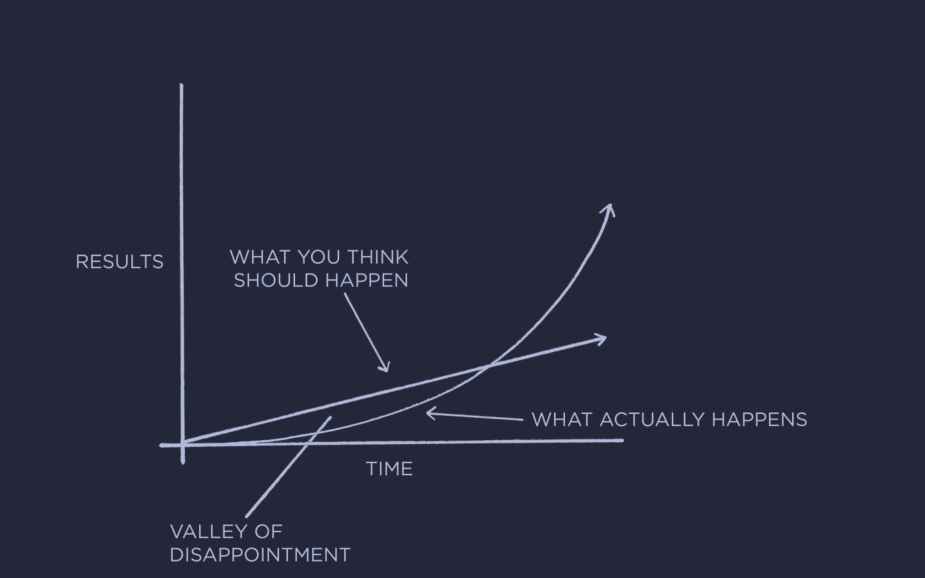
# Goals and systems
Forget about goals, the author says with a reason, because the goals are often misunderstood and have their use, but the systems that we use (whether its a sport or learning ) are more important. The system is: how we practice, how often, what we take in account etc are the things that at the end carries us to any goal, so it’s better to focus in the systems we use than the goals, and leaving goals only to have a sense of direction more than anything.
Some details with a goals only approach:
- “survivorship bias”, in a sport winners and losers can have the same goal (to win), in this case goals doesn’t make that much difference if they are the same for both teams.
- Goals are often temporary, addressing only the symptoms of the problem, and once achieved the cause of the thing we tried to solve will appear again, what needs to be fixed is the system that caused the problem (if our goal was to fix something). “Fixing the inputs, so the outputs will fix themselves.”
- If you fail at your goals you will (or might) feel yourself as a disappointment and think that you would only be happy/satisfied once you achieve goals, goals are only a tool and putting all that stress could really become not so good, if we set a system we can enjoy goals are more often out of the way with the problems they carry.
- Achieving goals can leave you feeling out of place, goals are difficult to manage on long term, in this case I relate in part, finishing a career on engineering can feel as an abrupt change, you only would get a job if you search for it and work for it if that is what you want and only doing the degree won’t guarantee anything, it would be better if I had a better system fixing things like bad sleep habits and what not.
# A system of atomic habits
He re-explains the meaning of atomic habits, marginal things made better in a constant way. Explaining that the focus of the book is in the systems that we put on use and the small habits we could implement in a larger system.
# ll. How your habits shape your indentity (and viceversa)
Author describes “three layers” of behavior change, the first and somewhat most superficial is outcomes, in the middle we have processes which means systems and finally we have identity in the center which is about our beliefs.
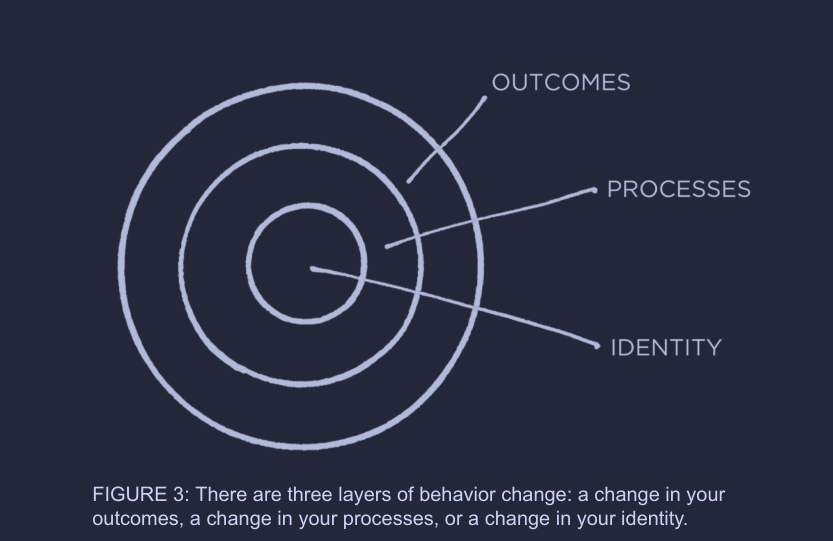
Habits are oriented on these three layers Often when we want to start a new habit we do it because we have a goal in mind we want to achieve, this habit would be an outcome-based habit.
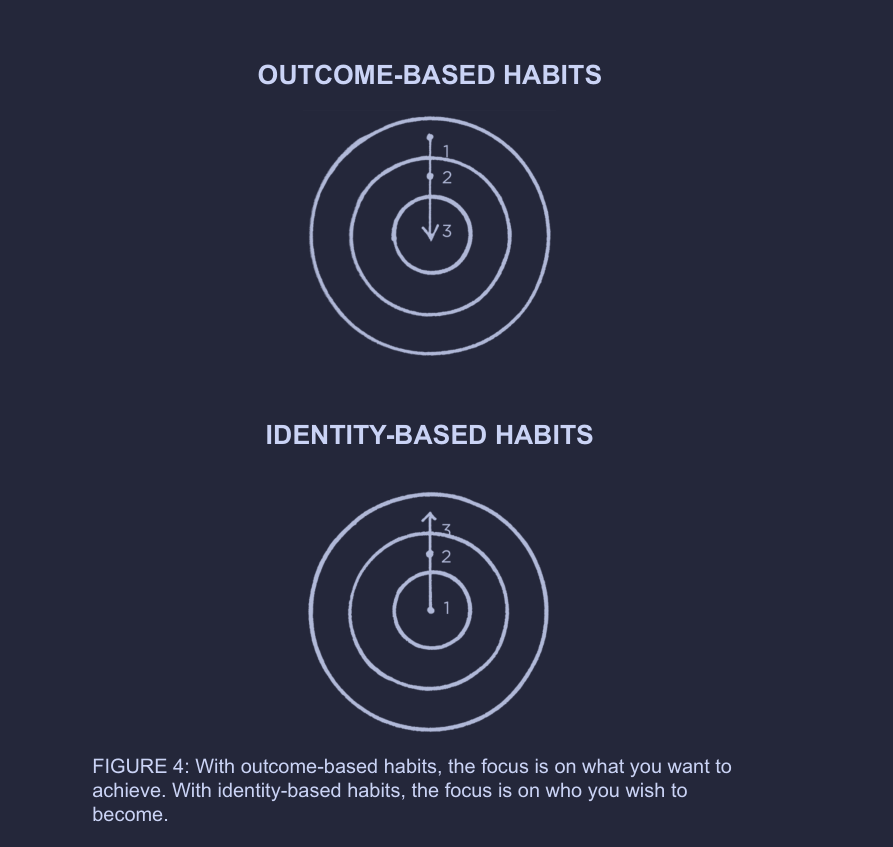
Why is difficult to change habits
It’s hard to change your habits if you never change the underlying beliefs that led to your past behavior. You have a new goal and a new plan, but you haven’t changed who you are.
A new habit will fail when…
Good habits can make rational sense, but if they conflict with your identity, you will fail to put them into action.
In this I could say that yes, over the time I found difficult to change things that I felt were not me in the identity self, thing I did believed like “I’m the kind of lazy person who gets up late” and similar stuff which made pretty difficult to change bad sleep patterns.
# The two-step process to change your identity
The two steps
- Decide the type of person you want to be.
- Prove it to yourself with small wins.
Basically, the author explains that you should focus on who you want to become. To change your identity for the better and explains that habits are the ones that contribute the most to our identity, every time we repeat an action this count as a vote for a certain type of person we are, if we decide the type of persone we want to be “healthy”, “organized” .. then we should take the majority of actions that makes us that type of person, that will constitute a better identity, making for a good habit.
# lll. How to build better habits in 4 simple steps.
Chapters starts telling a experiment done with cats where they learned certain behaviorsjjj after being put in a puzzle box so they could get a reward. He explains that actions that lead to a satisfactory outcome have more tendency to be repeated that the ones that don’t.
Also, the brain makes the habits to off-load the conscious mind, when we are doing something for the first time the brain has to focus a lot on it, after repeating it by forming an habit the brain can use the subconscious mind.
The 4 steps

- cue is the signal or hint that we might get a reward later by performing an action.
After all, the brain looks for these rewards as food, sex and other things to satisfy its needs of survival an reproduction which are one of the most important that humans come with.
- craving is the part of the motivation of desire that makes us take action.
about craving habits
What you crave is not the habit itself but the change in state it delivers
The craving comes right after we identify a cue.
- response, is the actual action, the habit we want to form
about responses
If a particular action requires more physical or mental effort than you are willing to expend, then you won’t do it. Your response also depends on your ability.
- reward, after we succesfully made a response we get a reward, these are the end goals of every habit. Rewards serve two purposes: they satisfy us and they teach us.
Rewards purpose is to fulfill the cravings we had, like getting the energy from the food we eat etc. Rewards also make us remember which actions are worth doing in base of the reward.
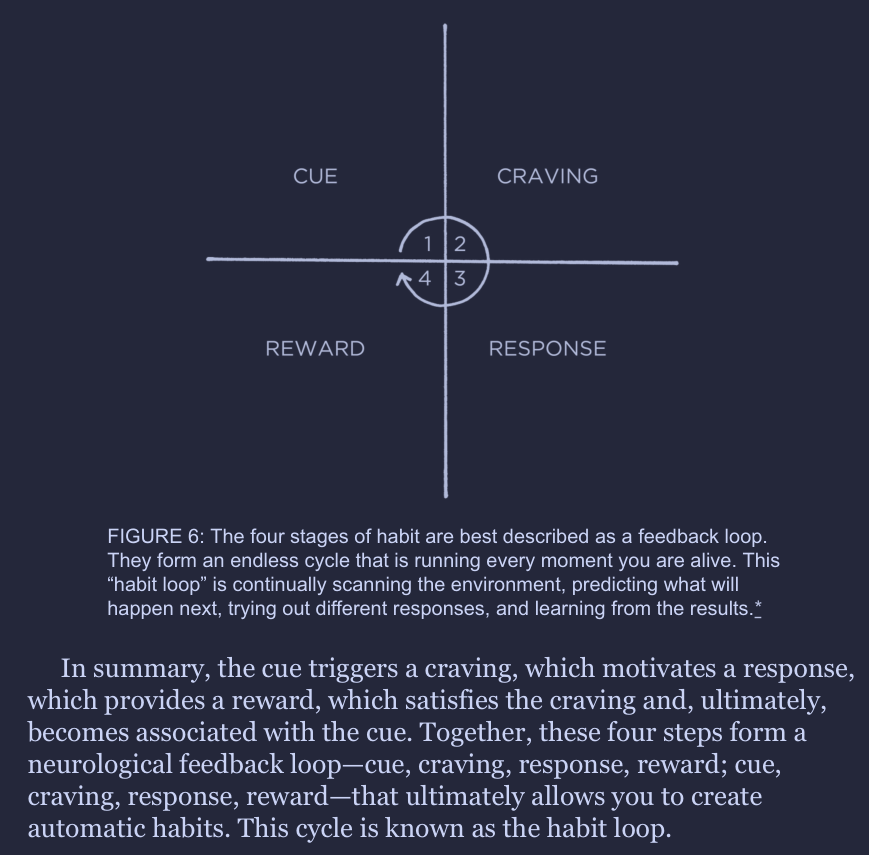
# The four laws of behavior change
This is a practical framework that involves the four stages described previously.
If we want to change or behavior we have to ask these questions:
- How can I make it obvious?
- How can I make it attractive?
- How can I make it easy?
- How can I make it satisfying?
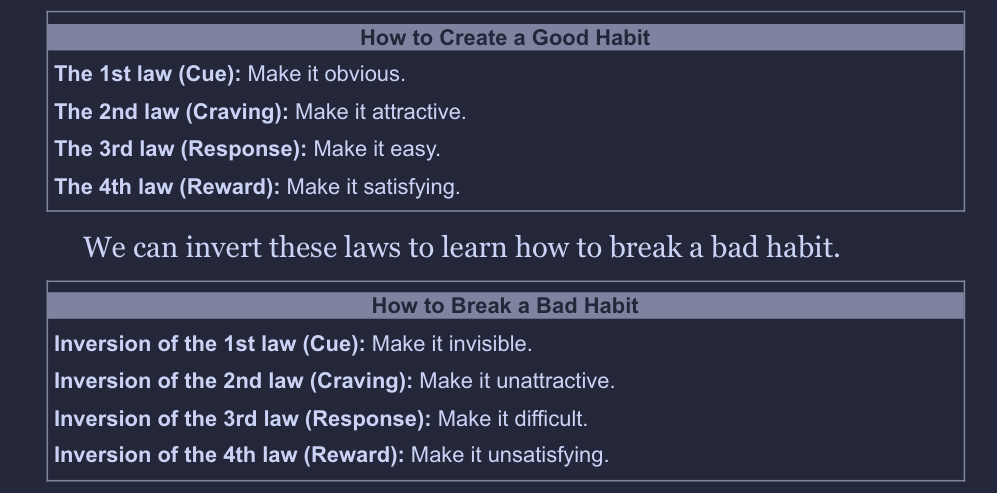
# lV. First law Make it obvious
“You don’t need to be aware of the cue for a habit to begin”
That is an advantage for the brain because it makes actions automatic, and at the same time makes habits dangerous if we aren’t aware of them. So the first step to behavior change is to list all the habits and try to identify the invisible ones that we do without even thinking.
List of daily habits (habit scorecard)
# V. The best way to start a new habit
Implementation intention
Implementation intention
Usually while trying to implement something new (like habits) it is mandatory to do the following if we want to succeed at doing it:
I will [BEHAVIOR] at [TIME] in [LOCATION].
- Meditation. I will meditate for one minute at 7 a.m. in my kitchen.
- Studying. I will study Spanish for twenty minutes at 6 p.m. in my bedroom.
- Exercise. I will exercise for one hour at 5 p.m. in my local gym.
Once we have a plan we don’t have to spend time or wait for motivation to do something vague as “being productive”, we just have to do the thing we have planned before, and as the author says, often what lacks is clarity instead of motivation.
# Habit stacking
We can use our current habits as leverage for new ones, we just have to make clear what habit.
Habit stacking formula
“After [CURRENT HABIT], I will [NEW HABIT].”
For example: Meditation. After I pour my cup of coffee each morning, I will meditate for one minute. Exercise. After I take off my work shoes, I will immediately change into my workout clothes. Gratitude. After I sit down to dinner, I will say one thing I’m grateful for that happened today.
In the following there are examples of habit stacking (in certain situation instead of habits.)
More situational, conditionals (general habit stacks)
- Exercise. When I see a set of stairs, I will take them instead of using the elevator.
- Social skills. When I walk into a party, I will introduce myself to someone I don’t know yet.
- Finances. When I want to buy something over $100, I will wait twenty-four hours before purchasing.
- Healthy eating. When I serve myself a meal, I will always put veggies on my plate first.
- Minimalism. When I buy a new item, I will give something away. (“One in, one out.”)
- Mood. When the phone rings, I will take one deep breath and smile before answering.
- Forgetfulness. When I leave a public place, I will check the table and chairs to make sure I don’t leave anything behind.
To create the right habit stack, we have to take in consideration that the stack or cue or trigger for the action we want to do has to have the frequency in which we want to perform the habit. If we want to clean up the house every day we wouldn’t choose to do it after we take out the garbage if we do it only 2 times per week.
# Vl. Motivation is Overrated; Environment often matters more
Environment
Environment is the invisible hand that shapes human behavior.
It is true that the environment we are in has a remarkable weight on what we do, and it often shapes us. In supermarkets they have designed certain environments so we buy more and that stuff. Fortunately, in the place we live in we can modify our environment to use it on our favor.
To implement a new habit, is recommended to choose a context that is not used for the bad habit we want to replace, because it’s easier to associate the cues on a new habit on a new context.
Why the phone is greatly terrible (context becomes not specific)
The cellphone is a great example of not having enough context in this case, you can do almost anything on it which can be great for its versatility, but at the same time we can’t associate just one thing to “cellphone” and usually the easier things are associated with it, which tends to be scrolling on social media, playing games etc.
# The environments are the cues
We pick up the cues every time from our environment, so if we set the environment and leave the cues that lead to good habits in an obvious way we are already on a win.
Every habit should have a home
You may be thinking, “You don’t understand. I live in New York City. My apartment is the size of a smartphone. I need each room to play multiple roles.” Fair enough. If your space is limited, divide your room into activity zones: a chair for reading, a desk for writing, a table for eating. You can do the same with your digital spaces. I know a writer who uses his computer only for writing, his tablet only for reading, and his phone only for social media and texting. Every habit should have a home.
That sounds a bit expensive to do in certain situations and perhaps not that practical, but I agree up to a certain point
environments
If you want behaviors that are stable and predictable, you need an environment that is stable and predictable.
# Vll. The secret to self-control
I found it interesting when the author explained about how we usually are almost obsessed with discipline, and that if we were to be disciplined all our problems would be solved. I agree that I’ve always thought of myself always lacking discipline blaming that for not being able to be consistent on anything I wanted to do without fault.
And that, to be disciplined you don’t need and immense amount of willpower, you just have to be on an environment that only leads to positive habits, so in here it’s important we can do our best to modify the environment for the better.
As an extra, he mentions one reason why addicts which have it difficult breaking the downwards spiral of their habits and that’s because they need to have an abrupt environment change, and when they return for rehabilitation to their old bad environment all the cues to re-take the addiction will still be there, and it’s not possible to beat the tentation with willpower on the long run.
Eliminating bad habits, making their cues invisible.
one of the most practical ways to eliminate a bad habit is to reduce exposure to the cue that causes it. If you can’t seem to get any work done, leave your phone in another room for a few hours. If you’re continually feeling like you’re not enough, stop following social media accounts that trigger jealousy and envy. If you’re wasting too much time watching television, move the TV out of the bedroom. If you’re spending too much money on electronics, quit reading reviews of the latest tech gear. If you’re playing too many video games, unplug the console and put it in a closet after each use.
# Second law Make it attractive
# Vlll. How to make a habit irresistible
As an introduction, he explains how animals tend to respond to certain situations. Normally in nature animals tend to give priority on situations where they would reach a goal, usually to trascend and reproduct themselves, surviving etc.
Humans on the other hand still have most of their old workings of the brain from thousands of years ago, but the current world is made full of temptations so you can buy and generate wealth for others, as junk food, social media, video games, etc.
Every product tends to become a supernormal stimulus of themselves, the frenetic pace of videos on platforms like tik tok to give an example.
temptations
We have the brains of our ancestors but temptations they never had to face
# The dopamine-driven feedback loop
# Wanting != liking
According to the author the brain puts more effort into the desire to perform an action rather that enjoying it, that anticipation, that craving has been demonstrated many times and is that craving we are looking for to implement in our own habits.
Image. The dopamine spike

# Using temptation bundling
The author explains, that to increase the odds to perform an habit that we need to do but don’t have that desire to do it we can create a condition where we do some other actions we really want to do only after we perform the habit we need to do.
Formula of tempt bundling and examples
The habit stacking + temptation bundling formula is:
- After [CURRENT HABIT], I will [HABIT I NEED].
- After [HABIT I NEED], I will [HABIT I WANT].
If you want to read the news, but you need to express more gratitude:
- After I get my morning coffee, I will say one thing I’m grateful for that happened yesterday (need).
- After I say one thing I’m grateful for, I will read the news (want).
If you want to watch sports, but you need to make sales calls:
- After I get back from my lunch break, I will call three potential clients (need).
- After I call three potential clients, I will check ESPN (want).
If you want to check Facebook, but you need to exercise more:
- After I pull out my phone, I will do ten burpees (need).
- After I do ten burpees, I will check Facebook (want).
# lX. The role of family and friends in shaping your habits
I found quite interesting the case of the Polgar sisters, by creating an environment that made playing chess something normal even praised and rewarded, Laszlo had their daughters to become world champions in that subject.
In that matter, from the moment we are born and beyond the norms and habits we pick up are the ones we see and imitate.
Belonging to a group can be a great thing for our ancestral social needs to belong to a group, that would re-inforce our beliefs or habits that we want to consider normal.
According to the author, we tend to imitate in three different ways:
- People close to us, like roommates, family etc.
- The many, in large groups, people tend to fit in the groups even when the groups has wrong opinions or don’t take the best decisions.
- The powerful, these people have many advantages and always had, so even if they are just popular people but are recognized in their field that we like we would search patterns to imitate, like study habits etc.
So we have to considere in what kind of groups or communities we are and what kind would be the ones we would like to be part of looking at their culture.
# Xl. How to find and fix the causes of your bad habits
The author explained that sometimes, we do not know or don’t have in consideration some underlying cravings, like eating for survival and energy, if we have a craving for a certain food we don’t think of it for survival but the craving is there in conjunction with some other underlying motives:
Underlying motives
- Conserve energy
- Obtain food and water
- Find love and reproduce
- Connect and bond with others
- Win social acceptance and approval
- Reduce uncertainty
- Achieve status and prestige
- ??? Survival (learning can be a survival strategic)
Some manifestations of underlying motives as specific cravings
Find love and reproduce = using Tinder Connect and bond with others = browsing Facebook Win social acceptance and approval = posting on Instagram Reduce uncertainty = searching on Google Achieve status and prestige = playing video games
Cravings and desires definitions by the author
A craving is the sense that something is missing. It is the desire to change your internal state. When the temperature falls, there is a gap between what your body is currently sensing and what it wants to be sensing. This gap between your current state and your desired state provides a reason to act.
Desire is the difference between where you are now and where you want to be in the future. Even the tiniest action is tinged with the motivation to feel differently than you do in the moment. When you binge-eat or light up or browse social media, what you really want is not a potato chip or a cigarette or a bunch of likes. What you really want is to feel different.
# How to reprogram your brain to enjoy hard habits
Making slight adjustments in the way we talk to ourselves and the way we frame the things we do each day can change a lot in the way we perceive these things, perhaps we always had talked to ourselves that getting up early was a burden, a hassle something you only do for school, instead if you see it as a blessing, an opportunity to do your things from early in the morning and to feel realized and healthy, that changes things a lot.
Title
These little mind-set shifts aren’t magic, but they can help change the feelings you associate with a particular habit or situation.
The same “re-framing” of things can be applied to change the bad habits we have, when we analyze them we can break the bad habits when looking at them in a different way that before we didn’t considered really.
Furthermore, we can create a motivation ritual by associating cues to something we enjoy, and using these same cues later when we need them to get the same feelings of motivations (or anything else we associate the cues with.)
Association of cues that we can use later as we like
You can adapt this strategy for nearly any purpose. Say you want to feel happier in general. Find something that makes you truly happy— like petting your dog or taking a bubble bath—and then create a short routine that you perform every time before you do the thing you love. Maybe you take three deep breaths and smile.
Three deep breaths. Smile. Pet the dog. Repeat.
Eventually, you’ll begin to associate this breathe-and-smile routine with being in a good mood. It becomes a cue that means feeling happy. Once established, you can break it out anytime you need to change your emotional state. Stressed at work? Take three deep breaths and smile. Sad about life? Three deep breaths and smile. Once a habit has been built, the cue can prompt a craving, even if it has little to do with the original situation.
# The third law Make it easy
# Walk slowly, but never backwards
# Habits work in the frequency domain
It really doesn’t matter that much how long you perform the action everyday, what matters is how often you do the action, every time we have to incline towards actions rather that motion.
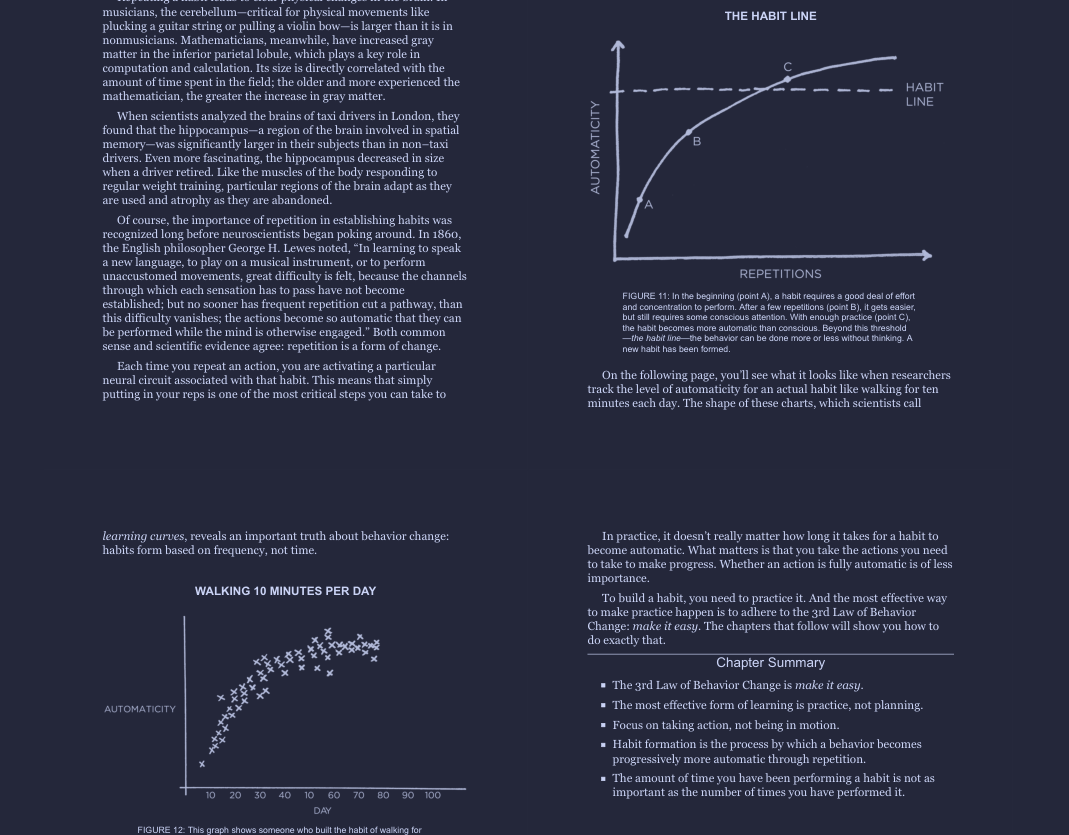
# Xll. The Law of Least effort
The author explains that we are incline towards decisions that require the less effort and produce the best results, explaining that energy is a valuable resource for the body.
# How to achieve more with less effort
The hose analogy is quite useful and I relate in part, it is difficult to depend only in motivation to do the things.
He also mentions the lean production, which is very known in engineering and what it does is to reduce the friction of the environment for the workers so they don’t have to waste time in a chaotic workspace.
The goal is to make the right things we want to do as friction less as possible, and leaving the bad ones with as much hassle and friction possible so we are not tempted to do them.
# Prime the environment for future use
Thinking ahead, when realizing that frequency is the key for habits to form, it’s better to have things in order READY to use. I sometimes have my desk full of stuff I’m not currently using, it can seem a hassle to put everything on their place (starting with assigning them a place.)
Once everything has a place it’s easier to know where everything is and only use it when we need them.
Ask the question
How can I design a world (environment) where it’s easy to do what’s right?
# Xlll How to stop procrastinating by using the two-minute rule
The decisions we make will say at the end of the day how good our day was, the first decisions of the day tend to be the most important of the day, getting up late in the evening for example is one of the worst decisions I’ve taken because It leaves you feeling sluggish, sleepy and overall not wanting to do nothing which just leads to poorest decisions.
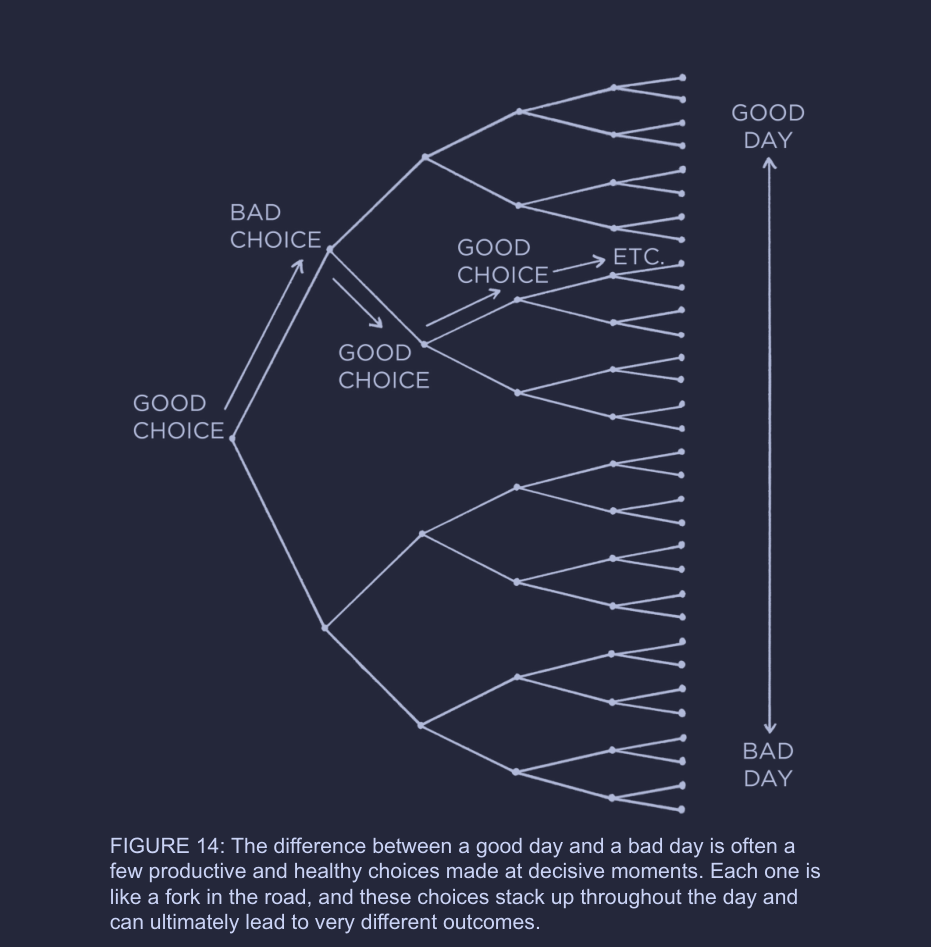
# The two minute rule
- [”] Make it easier to start and the rest will follow
The two minute rules states that, when you are trying to implement something new (a habit) sometimes we set goals too difficult which is fine but to start we must stablish a routine were we start with the easiest thing, shouldn’t take more than two minutes and usually has an equivalent.
examples
difficult achievable goal we start with run a marathon put your shorts and running shoes write a book open your text editor, write a paragraph. read a book read two pages
Alternatively, a more strict two minute rule version would be to only do something for a fixed time (2 to 5 min e.g) but no more, the author explains this works out because we focus more in forging our identity casting votes for what we do in a row of consecutive days, even when we only do 5 mins every day because at the end we know in the long run those 5 min every day will extend to a larger amount.
Why does the fixed 2 minute version works?
- Because sometimes we feel consumed by the end goal? and we over do the thing
Habit shaping
Habit shaping is defining our habits into phases or steps we take.
I think this is useful because even when we are at our best phase, we do idk 2 hours at the gym at max power etc, if someday we really feel bad we can only do phase 1 or phase 2, and that still will count as casting a vote towards our identity, instead of just leaving it alltogether.
more examples from the book of turning big actions into 2 minute forms
Nearly any larger life goal can be transformed into a two-minute behavior. I want to live a healthy and long life > I need to stay in shape I need to exercise > I need to change into my workout clothes. I want to have a happy marriage > I need to be a good partner > I should do something each day to make my partner’s life easier > I should meal plan for next week.
# XlV How to make good habits inevitable and bad habits impossible (commitment device)
A commitment device is a tool we can use to lock ourselves (we take actions to not to do bad actions) so we only can do the good actions we expect.
When we put ourselves in a situation when we have no other choice but to do the thing we expected to do at the beginning, then we had done a commitment device before.
book, commitment device
A commitment device is a choice you make in the present that controls your actions in the future. It is a way to lock in future behavior, bind you to good habits, and restrict you from bad ones. When Victor Hugo shut his clothes away so he could focus on writing, he was creating a commitment device.
# How to automate a habit and never think about it again
We have three tools for this:
- commitment devices
- one time decisions
- technology
The more we can automate our day to day tasks let it be technology (as with Full calendar, other reminders etc) we have more space for other things to do.
One time decisions are the ones that have a permanent impact in our quality life like getting a good mattress, improving sleep with good curtains etc.
onetime actions examples
Activity part What commitment devices do I employ? In what ways I make difficult bad habits
# The 4th law Make it satisfying
- ["] What is rewarded is repeated. What is punished is avoided.
- ["] Positive emotions cultivate habits. Negative emotions destroy them.
That includes interactions with other people, certain actions we do through the day and beyond.
Making something enjoyable is for the future
The first three laws of behavior change—make it obvious, make it attractive, and make it easy—increase the odds that a behavior will be performed this time. The fourth law of behavior change—make it satisfying—increases the odds that a behavior will be repeated next time. It completes the habit loop. But there is a trick. We are not looking for just any type of satisfaction. We are looking for immediate satisfaction.
# The mismatch between immediate and delayed rewards
The evolutionary logical explanation, is that we as humans have still the same equipment or architecture (our brains, other organs…) but the things we have made are very recently and so, a lot of our old functionality that helped us come to where we are now survival and others are still highly valued.
It’s more valued the immediate time in that sense because that¿s what ensures you survive in the wild but now we live in a delayed-return environment that benefits more on actions that will have an impact in the not immediate future, usually years and months.
The trick? To collaborate with our nature, looking for a way to add some of the immediate pleasure to the good habits, and adding some of the immediate pain or negative emotions to the bad ones.
# How to turn instant gratification to your advantage
- ["] The ending of any experience is vital because we tend to remember it more than other phases
# Using reinforcement
Similar to habit stacking which tied an habit to an immediate cue that makes obvious what to do next reinforcement ties an habit to an immediate reward, that makes the the ending of the habit worth remembering and doing later.
Reinforcement can be also used to inflict undesired emotions and connotations with the habits of avoidance.
Making avoidance visible with reinforcement
Avoiding an habit just because yes, doesn’t provide anything but unsatisfying sensations of not doing the bad habit.
Instead we can make our avoidance to the habit visible by doing something good every time we avoid said habit.
One solution is to turn the situation on its head. You want to make avoidance visible. Open a savings account and label it for something you want—maybe “Leather Jacket.” Whenever you pass on a purchase, put the same amount of money in the account. Skip your morning latte? Transfer 5 dollars. Pass on another month of Netflix? Move 10 dollars over. It’s like creating a loyalty program for yourself. The immediate reward of seeing yourself save money toward the leather jacket feels a lot better than being deprived. You are making it satisfying to do nothing.
We also need to keep in mind to use reinforcement that aligns with our identity, we wouldn’t choose as an immediate reward to going to the gym to get ice cream and burgers
# XVl. How to stick with good habits every day
The author explains that progress can be satisfying, even more when we have a visual representation of it, let it be moving paperclips for one jar to another every time we do X, or the best option, habit trackers that show our progress.
In general I like charts and already have made some habit trackers on obsidian, and yes, it feels nice to tick on the checkboxes for tiny good things I have to make everyday that I can visualize neatly with some plugins.
# Habit trackers
He suggests, using calendars is a great option on which we have symbols that represent the things we do.
Some benefits of habit tracking:
- It is obvious
- It just shows the results
Habit tracking makes us less biased
Habit tracking also keeps you honest. Most of us have a distorted view of our own behavior. We think we act better than we do. Measurement offers one way to overcome our blindness to our own behavior and notice what’s really going on each day. One glance at the paper clips in the container and you immediately know how much work you have (or haven’t) been putting in. When the evidence is right in front of you, you’re less likely to lie to yourself.
- It is attractive In general charts, graphics and stats look good. I feel there is a reason video games or other kind of entertainment use them to look at your progress and how far you’ve come
- It is satisfying The actual thing of casting the vote, checking an item on the daily note, and see how long you have made the streak its also a form of immediate and intrinsic gratification.
# When to track an habit
- ["] The completion of the behavior is the cue to write it down
It is a good practice to log the habit tracking once we finish doing it and use the “I tracked X habit” as a cue to go to the next habit on the habit stacking approach.
Formula Stacking + tracking
Contents After [CURRENT HABIT], I will [TRACK MY HABIT]. After I hang up the phone from a sales call, I will move one paper clip over. After I finish each set at the gym, I will record it in my workout journal. After I put my plate in the dishwasher, I will write down what I ate.
# The dangers of using badly habit trackers
Sometimes in presentations there can be used many types of charts to persuade the public. Charts, graphics and statistics can be misleading and we have to be aware that the goal is not the tracking really, or the number we get.
Quote on tracking
When we choose the wrong measurement, we get the wrong behavior.
This is sometimes referred to as Goodhart’s Law. Named after the economist Charles Goodhart, the principle states, “When a measure becomes a target, it ceases to be a good measure.” Measurement is only useful when it guides you and adds context to a larger picture, not when it consumes you. Each number is simply one piece of feedback in the overall system.
It’s also worth remembering that just because something can’t be measured or simply is not measured, doesn’t mean it’s not important and viceversa.
# XVll. How and accountability partner can change everything
It starts explaining how pain or negative experiences that happen after an action or behavior, is what makes us not want to repeat them.
That in a way we should look for things we don’t want to do to have an immediate pain infliction.
# The habit contract
It’s a way to add a compromise, by telling partners that you have certain goals and that you will receive certain punishment if you don’t accomplish your goals.
I don’t see this strategy useful, perhaps It could work short term but it would be easy to over work ourselves in the goals or set not so realistic ones, possibly leaving you not wanting to do the thing never, but hey, if it works for them.
# Advanced tactics How to go from being merely good to being truly great
# XVlll. The truth about talent (when genes matter and when not)
why
- ["] In short: genes do not determine your destiny. They determine your areas of opportunity
While obviously we have to be good to identify these areas of opportunity if we want to take advantage of them.
# How your personality influences your habits
yes
# questions that can help decide some things we are better suited to some tasks than others
What feels like fun to me, but work to others? What makes me lose track of time? Where do I get greater returns than the average person? What comes naturally to me?
# XlX The goldilocks rule, How to stay motivated in life and work
It is importante to keep our habits, this can be done by starting with very easy things to do, but to do them consistently.
It also explains that, once we can do the easy things with no problems we have to move forwards, that the brain also likes challenges but that are manageable.
graph “goldilocks rule”
# How to stay focused when you get bored working on your goals
Novelty and boredom , Machiavelli
“Men desire novelty to such an extent that those who are doing well wish for a change as much as those who are doing badly.”
other quotes from the book:
We all have goals that we would like to achieve and dreams that we would like to fulfill, but it doesn’t matter what you are trying to become better at, if you only do the work when it’s convenient or exciting, then you’ll never be consistent enough to achieve remarkable results.
When a habit is truly important to you, you have to be willing to stick to it in any mood
The only way to become excellent is to be endlessly fascinated by doing the same thing over and over. You have to fall in love with boredom.
# XX. The downside of creating good habits
On the bright side, habits that have been repeated many times become automatic, that itself can become a disadvantage if we are looking to really become excellent on what we are doing, otherwise if what we are doing are mundane or less important tasks to look for refinement as sweeping or dish washing is ok to leave them automatic.
# Reviewing habits (reflection and review)
Questions for yearly reports (reflection)
My yearly Integrity Report answers three questions:
- What are the core values that drive my life and work?
- How am I living and working with integrity right now?
- How can I set a higher standard in the future?
# How to break the beliefs that hold you back
- ["] When you spend your whole life defining yourself in one way and that disappears, who are you now?
Tao Te Ching / 道德經
Men are born soft and supple; dead, they are stiff and hard. Plants are born tender and pliant; dead, they are brittle and dry.
Thus whoever is stiff and inflexible is a disciple of death.
Whoever is soft and yielding is a disciple of life. The hard and stiff will be broken. The soft and supple will prevail.
—LAO TZU / Lao-Tse / 老子
YT narration of this chapter on chinese
on chinese
第七十六章
[原文] 人之生也柔弱①,其死也坚强②。草木③之生也柔脆④,其死也枯槁⑤。故坚强者死之徒⑥,柔弱者生之徒⑦。是以兵强则灭,木强则折⑧。强大处下,柔弱处上。
Defining identity on a flexible way
The key to mitigating these losses of identity is to redefine yourself such that you get to keep important aspects of your identity even if your particular role changes.
- “I’m an athlete” becomes “I’m the type of person who is mentally tough and loves a physical challenge.”
- “I’m a great soldier” transforms into “I’m the type of person who is disciplined, reliable, and great on a team.”
- “I’m the CEO” translates to “I’m the type of person who builds and creates things.”
# Conclusion
- ["] The secret to getting results that last is to never stop making improvements. That’s the power of atomic habits. Tiny changes. Remarkable results.
